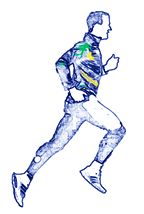One of the best things that runners can do for their performance is to increase their lung power. When going up hills or on long distance runs, lung power is needed to power the body and provide oxygen to the muscles. By pulling in extra air, it allows runners to surge up hill and keep a strong cadence. Far too often, runners only consider training their cardiovascular system and their legs. Although these are important aspects of running, better breathing power will allow for more oxygen and better endurance.

The diaphragm is a muscle that is beneath the lungs and separates the chest from the upper abdomen. When the diaphragm moves, it changes the pressure in the chest so air is sucked into the lungs like a vacuum. To exhale air, the diaphragm contracts and the vacuum-like pressure is removed. This entire action takes place continuously so that people can breath. Out of each breath, 80 percent of the work is actually performed by the diaphragm.
By strengthening the diaphragm, runners can increase their endurance and reduce fatigue. Studies supporting this research was performed by researchers at the Center for Sports Medicine at Brunei University. They tracked fatigue levels among marathoners. Through this work, they managed to find a link between runners who had the most difficulties breathing and leg weakness. This led to the conclusion that respiratory muscles that had to work harder caused the legs to struggle more during the race. The best way to reduce fatigue during running is to learn how to breath more fully. There are air sacs within the lungs that hold air. If breathing is deeper, these air sacs are able to absorb more oxygen. This oxygen is then fed to the muscles. During a normal workout, runners should focus on taking slow and deep breaths. Over time, this will help to strengthen the diaphragm. Many runners tend to breath with their chest instead of their stomach. To figure out if the runner is breathing correctly, they should run a mile at their normal pace. After the mile, they should put one hand on their stomach and one hand on their chest. Ideally, the lower hand should be the one moving. In most cases, the reverse happens because the runner is breathing with their chest. When someone uses their chest to breath, it causes their shoulders to move frequently and to become tense. This ends up being a lot of wasted energy that could otherwise be used for running.
To break the habit, runners should start practicing belly-breathing whenever they are not running. Over time, they will be able to make this style of breathing a habit that they use during their regular running routine. Another method of encouraging the switch is to do Pilates. This workout was made to help rehabilitate soldiers and works to improve breathing techniques and core strength. Breathing Right Using the mouth to breath is the first step. Since it is larger than the nostrils, it is easier to take in more oxygen. With the mouth open, the face also becomes more relaxed so deeper breathing becomes easier. Runners can also try to breath in patterns. They can try a 2-2 pattern breath. With the first step left and right, they breath in. On their next left and right steps, they breath out. Gradually, they can increase this pattern to 3-3 breath and a 4-4 pattern. Learning from Pilates There are two different Pilates moves that runners can adopt for better breathing. They work to strengthen the diaphragm and improve the posture. Overall, this makes it easier to run longer distances with less effort. The first move is known as the Hundred. Individuals should lie on their back. The arms should be at the side, knees bent and the feet should be flat on the floor. Gradually, they should lift their neck, shoulders, arms and head from the ground. The knees should also be raised and extended until they are completely straight. At this point, the runner should take five short breaths in and out. While doing this, the arms should be moved slowly up and down. Overall, the runner should complete 10 sets of the exercise. With consistent work, this exercise will help control the breathing and make sure that inhales and exhales are in balance. As a side benefit, it also strengthens the stomach muscles.
Another exercise that works well is the standing chest expansion. In a standing position, the runner should keep their arms at their sides and slightly bend their knees. On each inhale, they should rotate their arms upwards so the biceps are next to the ears and the palms are facing one another. On the exhale, the arms should be swept back to the sides. This exercise should be repeated four times.

